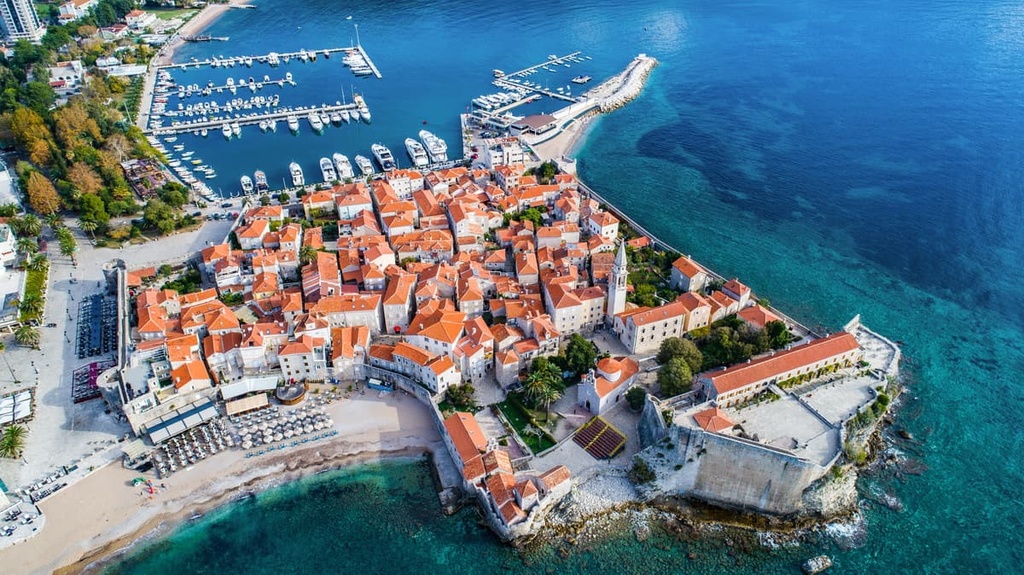Get PeakVisor App
Sign In
Search by GPS coordinates
- Latitude
- ° ' ''
- Longitude
- ° ' ''
- Units of Length

Yes
Cancel
Share ×

Scan the QR code and open PeakVisor on your phone
❤ Wishlist ×
Choose
Delete
Lovćen National Park lies in the heart of Montenegro and it protects the beautiful Lovćen massif. You can see the whole country from the “Sacred Altar” on Lovćen, which is where a local folk hero is buried. Here, you can also enjoy beautiful views of the Dinaric Alps and the Adriatic Sea. There are 41 named mountains in Lovćen National Park. The highest and the most prominent peak in the park is Štirovnik (1,748 m/ 5,735 ft).
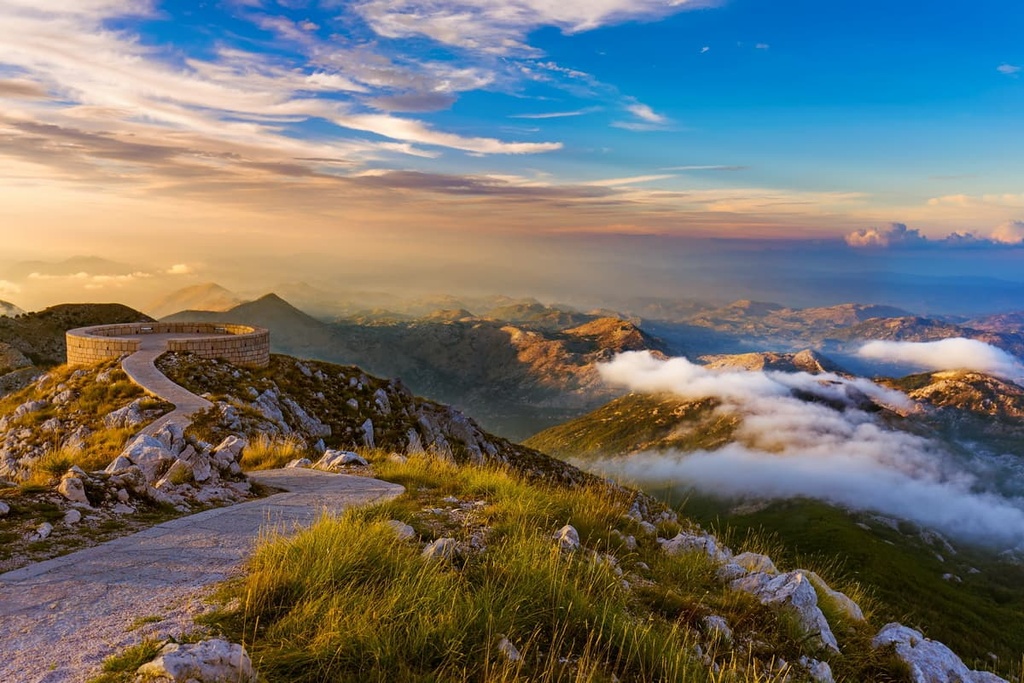
Lovćen National Park is a national park located in southern Montenegro. It covers an area of 6,400 ha (15,814 acres). Local authorities established the national park in 1952, and it has been protected ever since.
Lovćen is a massif in the Dinaric Alps that rises steeply from the edge of the Adriatic Sea. From Lovćen, you can enjoy magnificent views of the amazing Boka Kotorska (Kotor Bay), which is one of the most beautiful areas in the Balkan Peninsula.
To the east and southeast, the slopes of Lovćen stretch all the way to the karstic fields of Cetinje. Below the massif lies the Rijeka Crnojevića River and Skadarsko Lake. To the north and northeast, the Montenegrin coastal area or the Adriatic Sea stretches outward from the base of the massif.
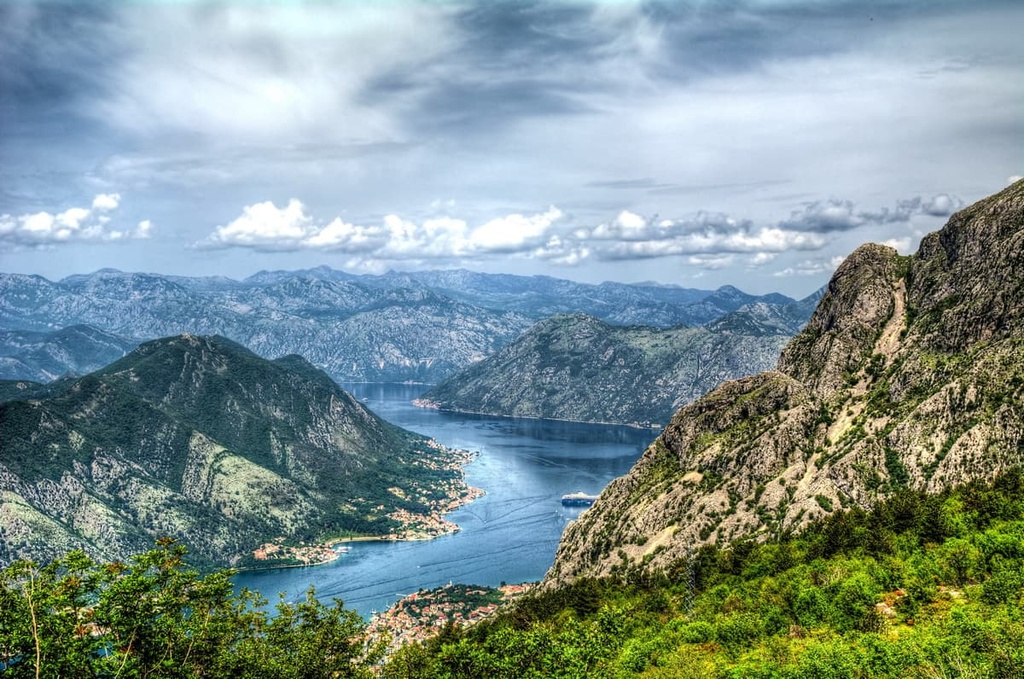
If you're in Perast or Kotor, you can see the entire massif from town. Lovćen lies in the southwestern part of Montenegro, and it rises up from the edge of the Adriatic Sea. It's long been nicknamed the "Sacred Altar" and it is one of the main sights in Kotor's hinterland.
Lovćen National Park is located along the coast, and it stretches from the Bay of Kotor to Lake Skadar. Kotor Bay is situated near Montenegro’s border with Croatia along the Adriatic Sea.
Additionally, Lovćen is nestled along the border of two different climate zones. It lies in the hinterland of the Adriatic Sea between the water and the Dinaric Alps. Because of this, it's home to an incredible diversity of ecosystems.
The massif itself features a number of peaks, such as Štirovnik (1,748 m/ 5,735 ft) and Jezerski (1,657 m/ 5,436 ft) peaks. The landscape of the Lovćen mountain is unique because of the many ravines and deep pits that are present in the region’s karst topography.
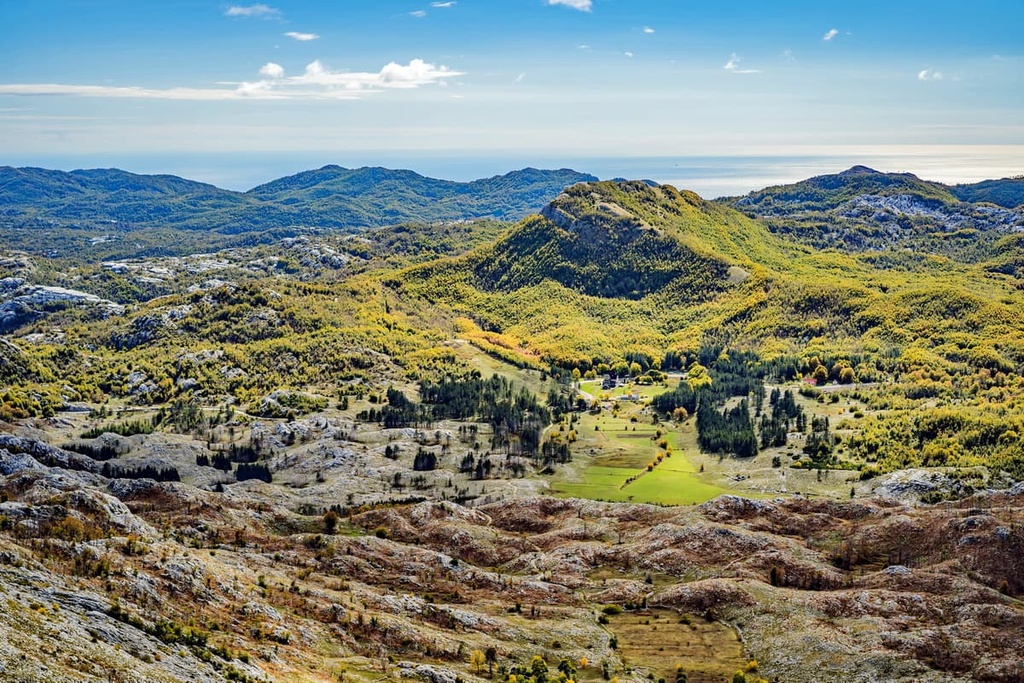
In Lovćen, you can visit the mausoleum of the Montenegrin ruler and poet Petar II Petrovic Njegos, who wrote The Mountain Wreath. To get to the mausoleum, you need to climb 461 stairs from the parking lot. From the top, you can enjoy an amazing view of the city.
Petar II Petrovic Njegos was born in Montenegro in 1811 or 1813. His uncle, Petar I, designated him as the successor to the Montenegrin throne and became the ruler of the Prince-Bishopric of Montenegro in 1830. However, Petar II died in 1851 of tuberculosis at the young age of 38.
Njegoš is one of Montenegro's most famous poets. One of his best works, The Mountain Wreath (Gorski Vijenac), is one of the most notable examples of Serbian-Croatian poetry and it’s more widely known around the world than nearly any other piece of literature from the region.
Most of the sacred buildings and interesting ethnographic materials on Lovćen lie in the village of Njeguši, which is also known for its excellent prosciutto and cheese.
The Lovćen area is also a place where you can learn about the rich culture of the Ancient Slavs and try some medovica, which is a type of traditional liqueur. The Lovćen area is also full of old stone houses with thatched roofs that are called katuni.
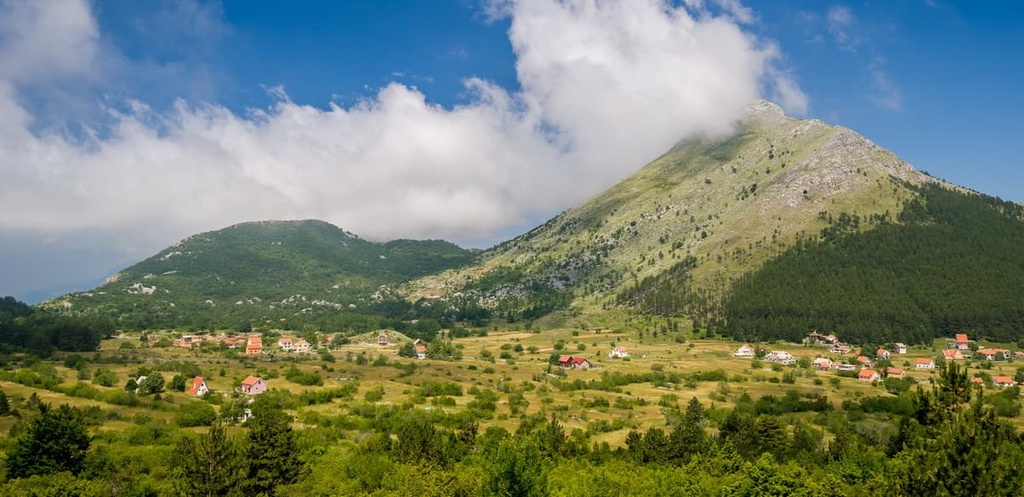
Montenegro is one of the smallest Balkan nations, and it is located in the northwestern part of the peninsula.
The Lovćen massif is the largest mountainous area in the southern coastal region of Montenegro. This densely forested massif consists of carbonate rocks, most of which formed between the Triassic and Cretaceous periods.
Much of the park is dominated by karst landforms, particularly in its mountainous regions. Most of the rocks in the area are limestones or dolomites. Karst topography is a landscape formed by water erosion and the underground dissolution of soluble rocks, mainly limestone. Because of these natural processes, areas of karst topography support a unique collection of plants and animals.
In more recent millennia, the park also experienced widespread glaciation. These glaciers helped to carve out the region’s valleys and peaks. During this time, the glaciers typically reached elevations of around 1,300 m (4,265 ft) to 1,500 m (4,921 ft), so any peaks that were below those elevations were typically eroded away by the glaciers to create more rounded summits.
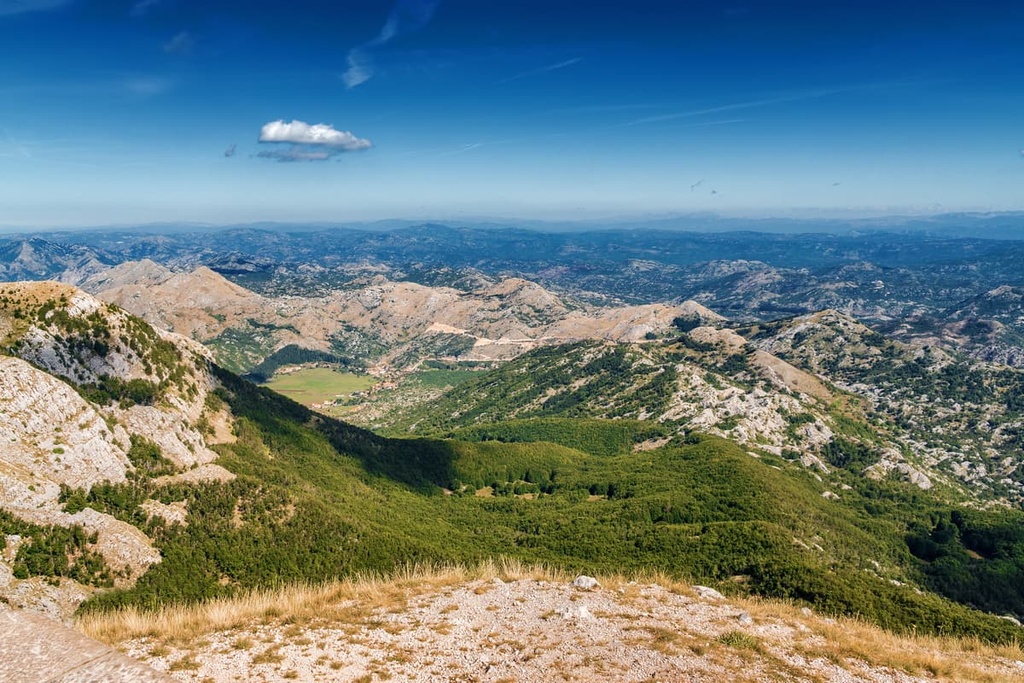
Major peaks in Lovćen National Park include Štirovnik (1,748 m/ 5,735 ft), Jezerski (1,657 m/ 5,436 ft), Babljak (1,604 m/ 5,262 ft), Goliš (1,570 m/ 5,151 ft), Treštenički vrh (1,489 m/ 4,885 ft), Babina glava (1,474 m/ 4,836 ft), and Ðurđevac (1,455 m/ 4,773 ft).
Lovćen National Park is located in the western part of Montenegro, and it contains a diversity of flora and fauna. The geographical position and climate of the park have given it the ability to support rich ecosystems.
Researchers believe that approximately one-third of the total number of plant species in Montenegro live on the Lovćen massif. This includes about 1,300 herbaceous plant species.
Of the many ecosystems found in this area, beech forests are the most common as they cover about 70 percent of the park’s forested terrain. The park is also home to some stands of black pine, and it features a plethora of other ecosystems such as alpine meadows, rocky slopes, and caves.
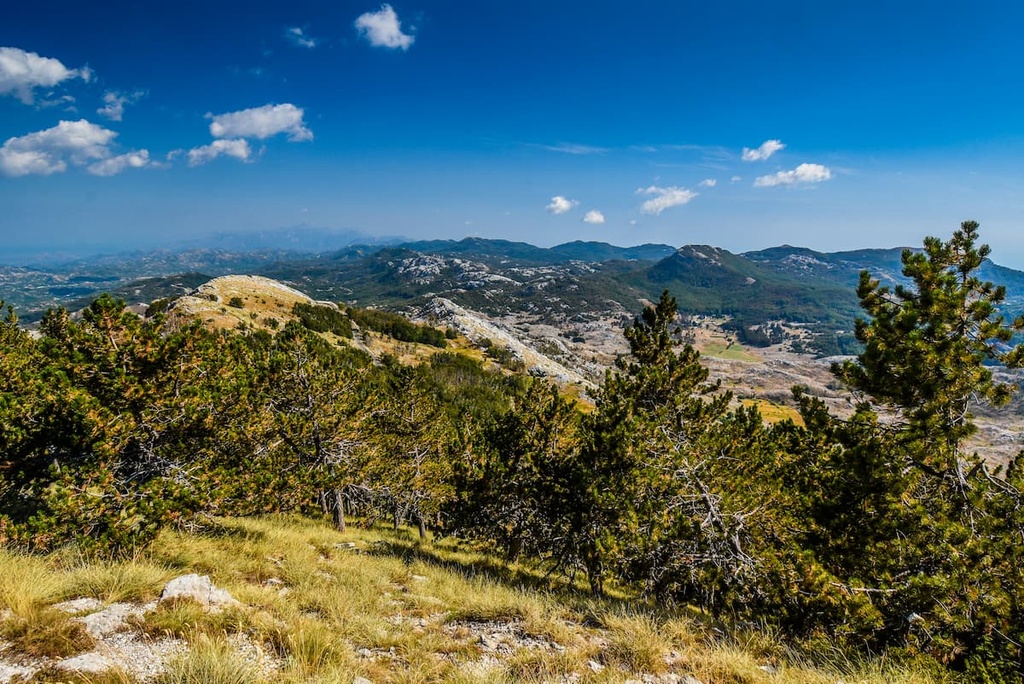
Large mammals that live in the park include species like boars, wolves, foxes, bears, rabbits, and deer. Small mammals aren't well studied in the area, but 14 species have been recorded so far. Some of the smaller mammals that live in the park include the white-breasted hedgehogs, blind moles, and squirrels.
Over 200 species of birds visit Lovćen National Park, and there are always a few at the park during different seasons. Some of the species that you can find in the area include black-tailed shrubs, robins, woodpeckers, partridges, and nightingales, among others.
The park is also home to 11 species of reptiles, including forest turtles, Mosor lizards, green lizards, large green lizards, European glass lizards, white lizards, and wall lizards.
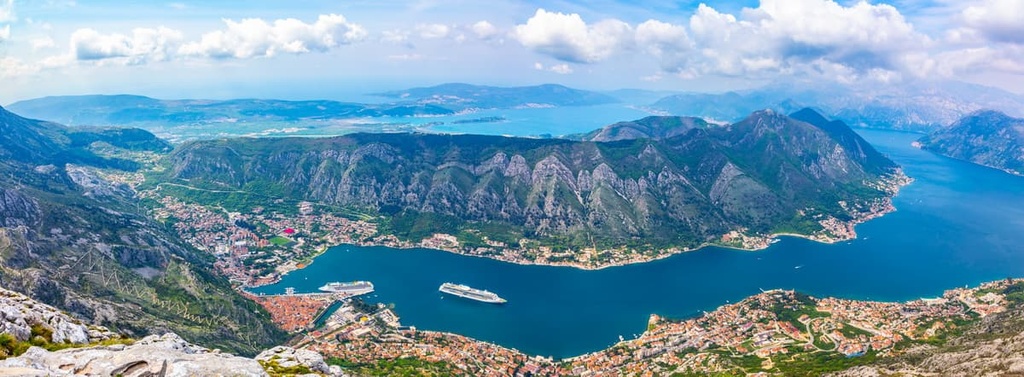
The Lovćen area has long been home to humans. It’s believed that some of the first people to settle here were the Illyrians. They built a city in the Kotor Bay and their territory once extended across much of the Balkans.
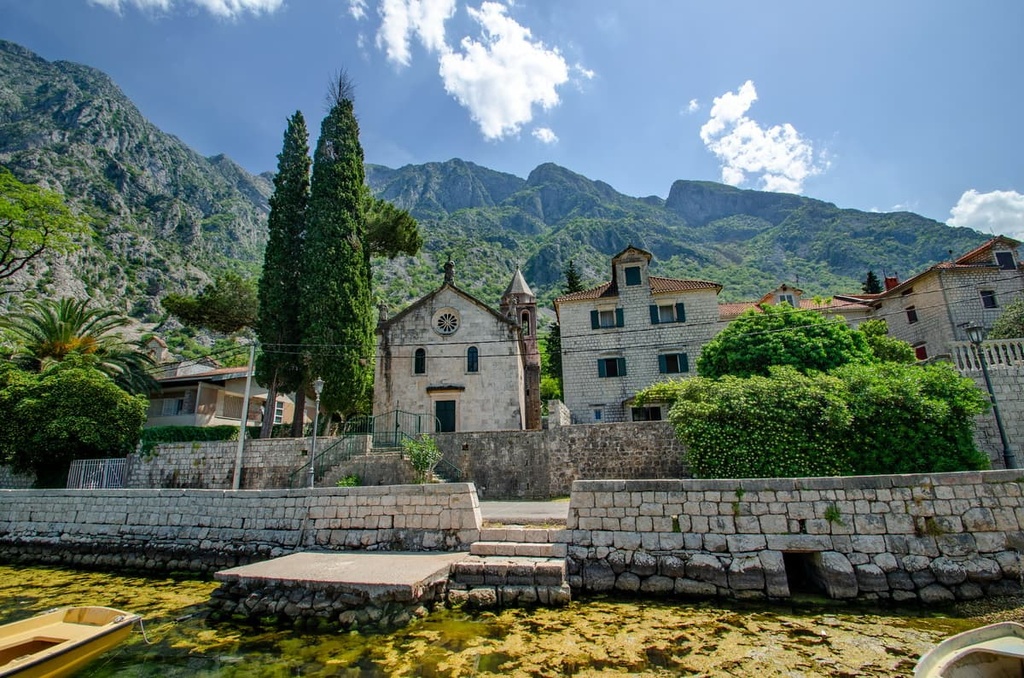
Soon the Romans took over the area and named the land Illyria. A few centuries later came the Slavs, who formed some of the region’s first medieval kingdoms. At different points in history, Lovćen was part of the kingdoms of Serbia, Bosnia, and Zeta.
There are a number of important places in the region in and around the park, though Cetinje is one of the most notable. It was founded in the fifteenth century and it became the main Christian stronghold of this part of Europe during the Ottoman conquest.
The city played such an important role in Montenegro’s history that it’s considered to be one of the country’s honorary capitals. In fact, it is currently home to the official residence of the Montenegrin president.
Additionally, there’s a mausoleum for Petar II Petrovic Njegos in Lovćen National Park that happens to be one of the most popular attractions in Montenegro.
Petar II Petrović-Njegoš is a Montenegrin icon and folk hero. He ruled Montenegro from 1830 to 1851, united the country's different factions, and was known for modernizing the state. Njegos was also considered one of the best South Slavic poets of his time.
In 1916, Njegoš's remains were secretly transferred to the monastery in Cetinje. They were greatly damaged by the Austro-Hungarian Army during World War I. Four years later, the Yugoslav authorities built the mausoleum and authorized the transfer of Petar II Petrović-Njegoš’s remains to their new resting place.
After the Second World War, a new church was built on the site of the mausoleum. Local authorities approved the construction of the new church in 1951, and it took 23 years to complete. It opened to the public in 1974.
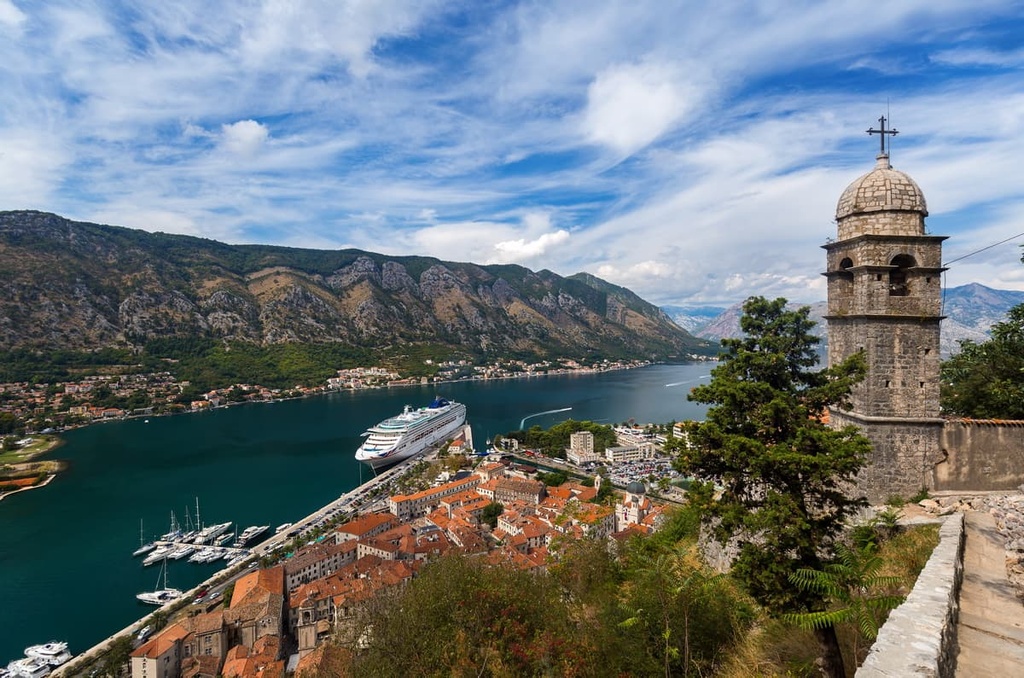
From the top of the mausoleum in Lovćen National Park, you can view Kotor Bay and Katun Nahija. It can be hard to get to Njegoš's mausoleum during the winter months because there is typically a lot of snow on Lovćen until May. You can get to it via road from Cetinje, which is located about 13 km (8 mi) away.
The Lovćen area was proclaimed a national park in 1952 when the mausoleum construction started. In many respects, the park is a place of national pride for Montenegrins due to its rich cultural heritage and beautiful landscapes.
In addition to hiking, visitors to Lovćen National Park can also enjoy a number of mountain biking trails and sightseeing opportunities. Here are the best hikes in Lovćen National Park to check out during your next trip to the region.
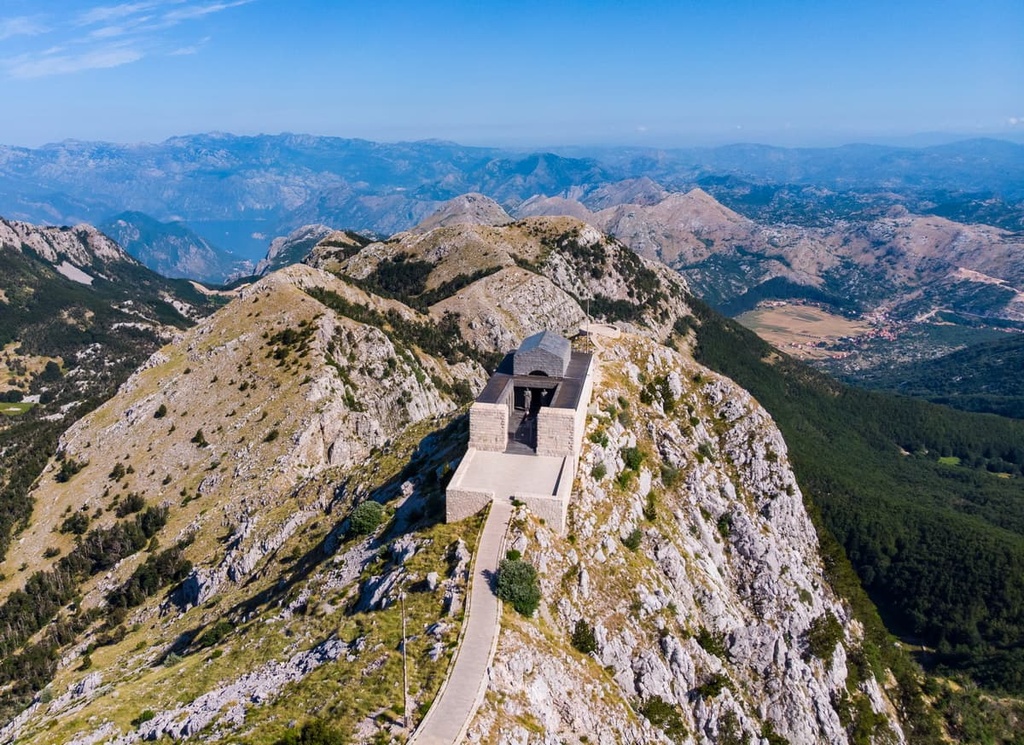
Lovćen lies above Kotor, a seaside city. The road that connects these two places runs along the coast and offers visitors many wonderful views of the Bay of Kotor. But be warned: the road is steep. There are also switchbacks (25 in total) on this road, so it can be quite a challenging drive.
You can start your hike from either the San Giovanni Fortress or the Ladder of Kotor. From here, you’ll ascend the mountain via an old horse road. The hike takes 10 km (6 mi) to complete and has a lot of elevation gain.
One can also hike from Kotor to Lovćen and enjoy the breathtaking view of the bay from the top of the road.
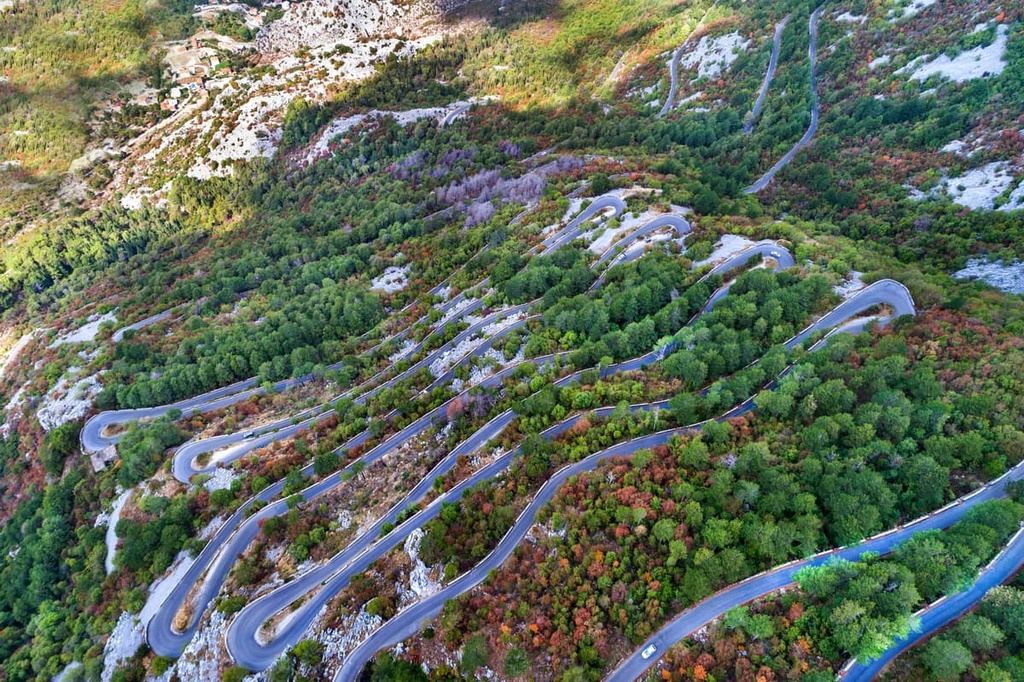
The Lovćen Wolf Trail is one of the most popular trails in the park. It takes you through a beech forest and visits some beautiful lookout points. This hike starts at the Lovćen Centre, which is in Ivanova Korita, and heads out to a handful of scenic overlooks.
The Wolf Trail is 7 km (4 mi) long and it has almost no elevation gain, so it takes most people about 3 to 4 hours to complete. Along the way, you will reach Kuk and Kraljevo Počivalo lookout points, and the road will take you back to your starting point.
The hike to the Njegoš Mausoleum is moderate to difficult, as the last part of the trail is very steep and exposed. It’s best to do this hike early in the morning so you can avoid the heat of the midday sun.
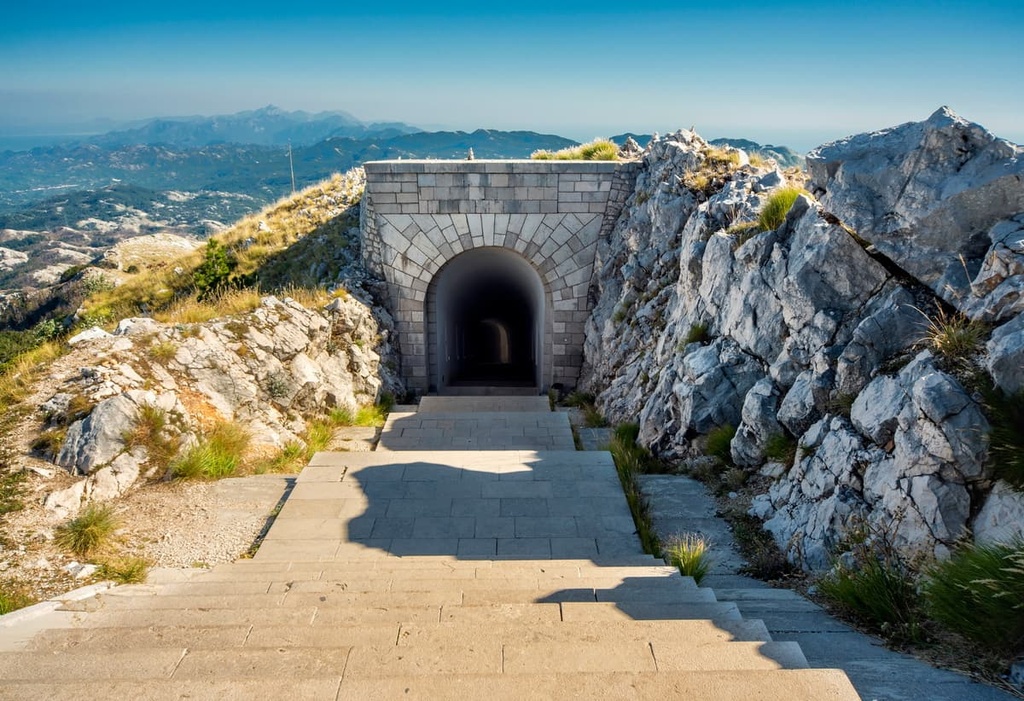
This trail takes you from Ivanova Korita to the Njegoš mausoleum on top of Jezerski (1,657 m/ 5,436 ft) and back again. It is about 11 km (6.8 mi) long and it normally takes around 4 hours to complete.
Looking for a place to stay during your next visit to Lovćen National Park? Here are a few of the best cities in the region to check out before or after your trip to the park.
Cetinje is the closest city to Lovćen National Park. It features a rich history and culture that’s well-preserved within its city walls. The Romans founded Cetinje, and it was subsequently occupied by the Venetians, Austrians, and Ottomans before it finally became part of Yugoslavia in 1945.
Cetinje has a long history as one of the most important cities in Montenegro because of its strategic location at the entrance into the Montenegrin hinterland. You can get to it via road and rail. There are many hotels, rental apartments, B&Bs, and camping areas in and around the city, too, if you’re in need of accommodation during your stay.
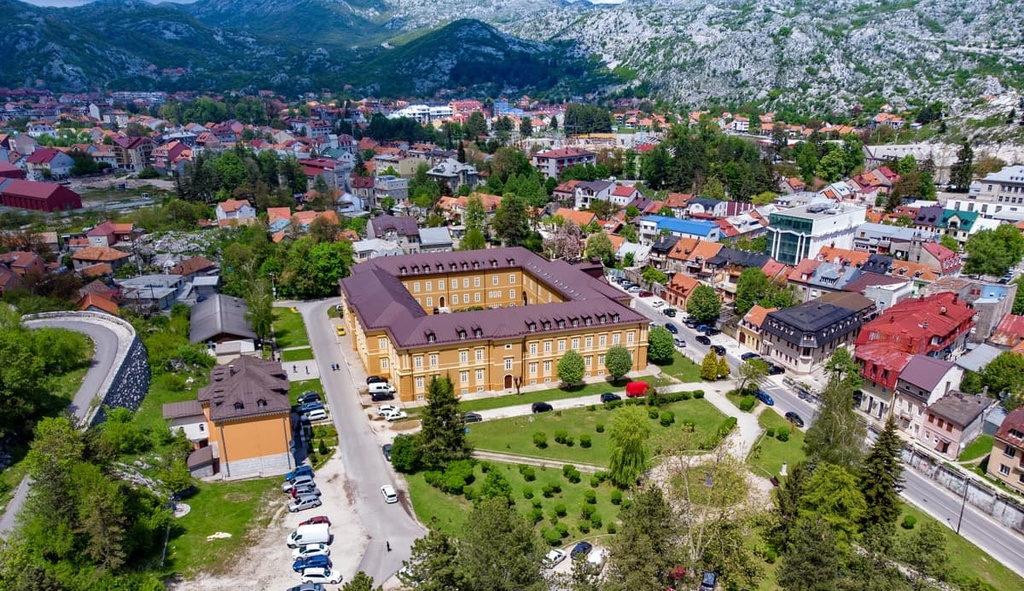
Kotor is a small town located in the Bay of Kotor along the Adriatic coast of Montenegro. It is a popular tourist destination and has been inhabited since ancient times.
Venetian merchants founded the current city in 1420, and it soon became an important trading center for goods heading from Venice to Dubrovnik, Ragusa, and beyond. That said, the area around the bay was inhabited by Illyrians long before the Venetians arrived.
Kotor is known for its picturesque setting, medieval architecture, rich cultural heritage, and historical monuments. One can find all kinds of accommodation in the city, and you can reach it via road, rail, and water.
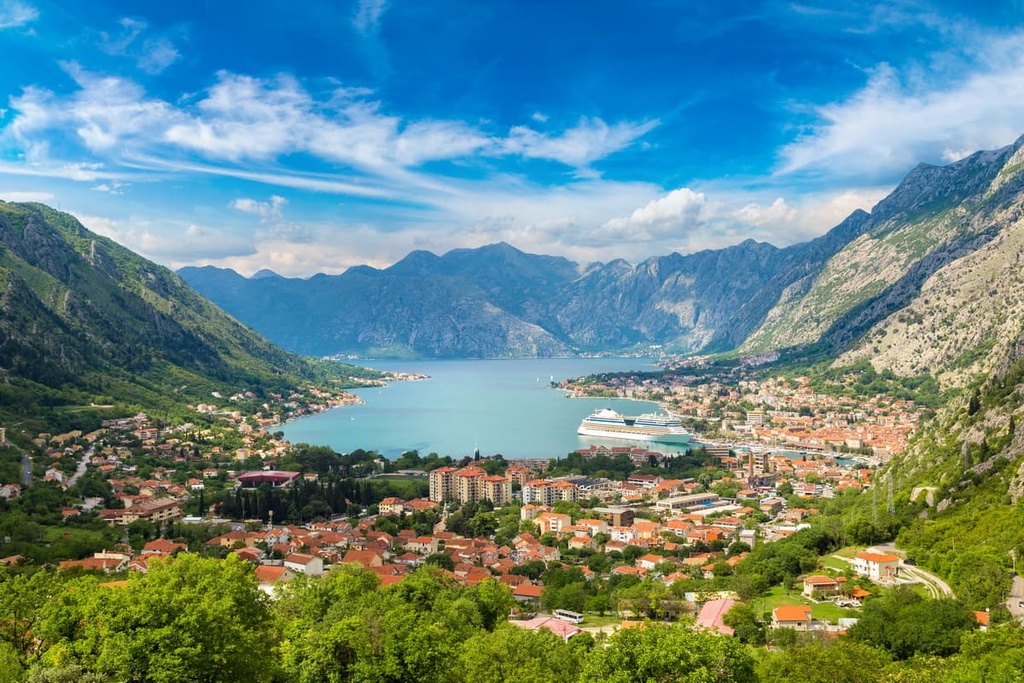
Budva is a beautiful seaside resort town. It is located on the Adriatic Sea and has been inhabited since prehistory.
Budva has always been a popular tourist destination for Montenegrins, but it wasn’t until recently that it became an international hotspot for travelers. In the last few years, there has been a massive increase in tourism to Budva, which has led to many new developments in the city and increased interest in creating a more robust tourism industry.
With more tourists coming to Budva, there are now more hotels in the city than ever before. This means that you have plenty of options for activities and accommodation in Budva during your next trip to the region.

Explore Lovćen National Park with the PeakVisor 3D Map and identify its summits.

